What is Linocut? A Beginner's Guide to This Unique Art Form
Ever been mesmerized by a work of art, its intricate lines and shapes seemingly conveying a tale all their own? That's the magic of linocut, an art form that turns simple linoleum into stunning works. This humble medium allows artists to carve out their creativity, literally.
Linocuts might seem old-school in this digital age, but they're making a comeback as people rediscover the joy of creating with their hands. The process is straightforward: You sketch your design onto a block of linoleum and then use sharp tools to cut away areas where you don't want ink—essentially carving out your negative space.
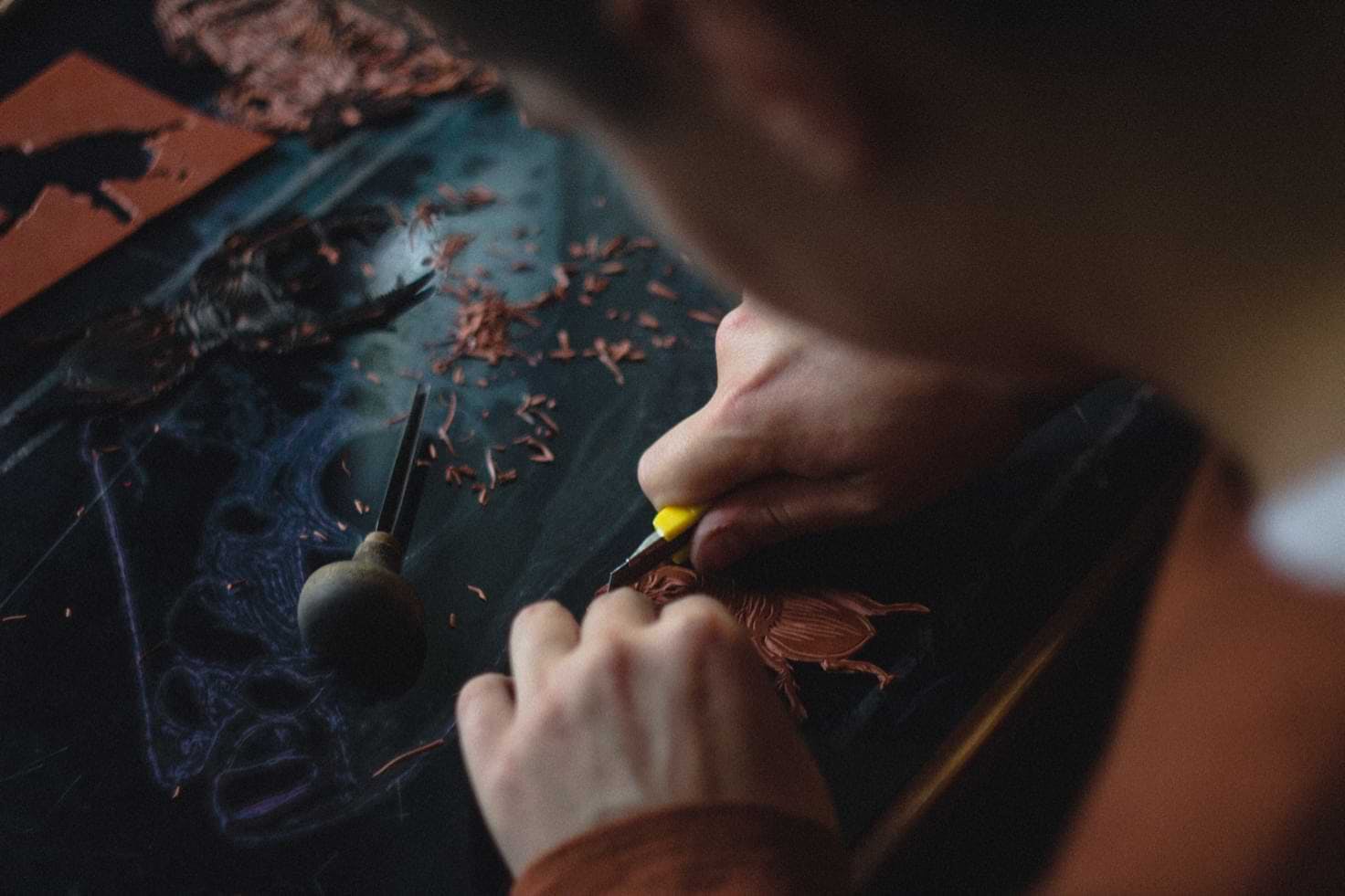
Got your interest, huh? Keep reading and you'll discover how Picasso made these prints famous. You'll also understand why limited edition linocuts are such a steal for collectors today. We're about to dive into
Table of Contents
- Understanding the Art of Linocut
- Tools and Materials for Creating Linocuts
- The Process of Designing a Linocut
- Carving and Printing Your Linocut
- Techniques and Tips for Mastering Linocut
- Collecting and Appreciating Linocut Art
- Preserving and Caring for Linocut Prints
- FAQs in Relation to What is Linocut
- Conclusion
Understanding the Art of Linocut
The artistic realm is immense and diverse, with an abundance of ways to express oneself. One such medium that stands out for its distinctive aesthetic and accessible technique is linocut. But what exactly is linocut? It's a type of relief printmaking, similar in nature to woodcutting and engraving.
A key player in popularizing this form was none other than Pablo Picasso himself. Yes, you heard it right; the legendary artist found appeal in this unique art form. You might ask why he would favor something as simple as linocuts. The answer lies within the medium itself: lino printing provides an unmatched versatility combined with relative ease-of-use.
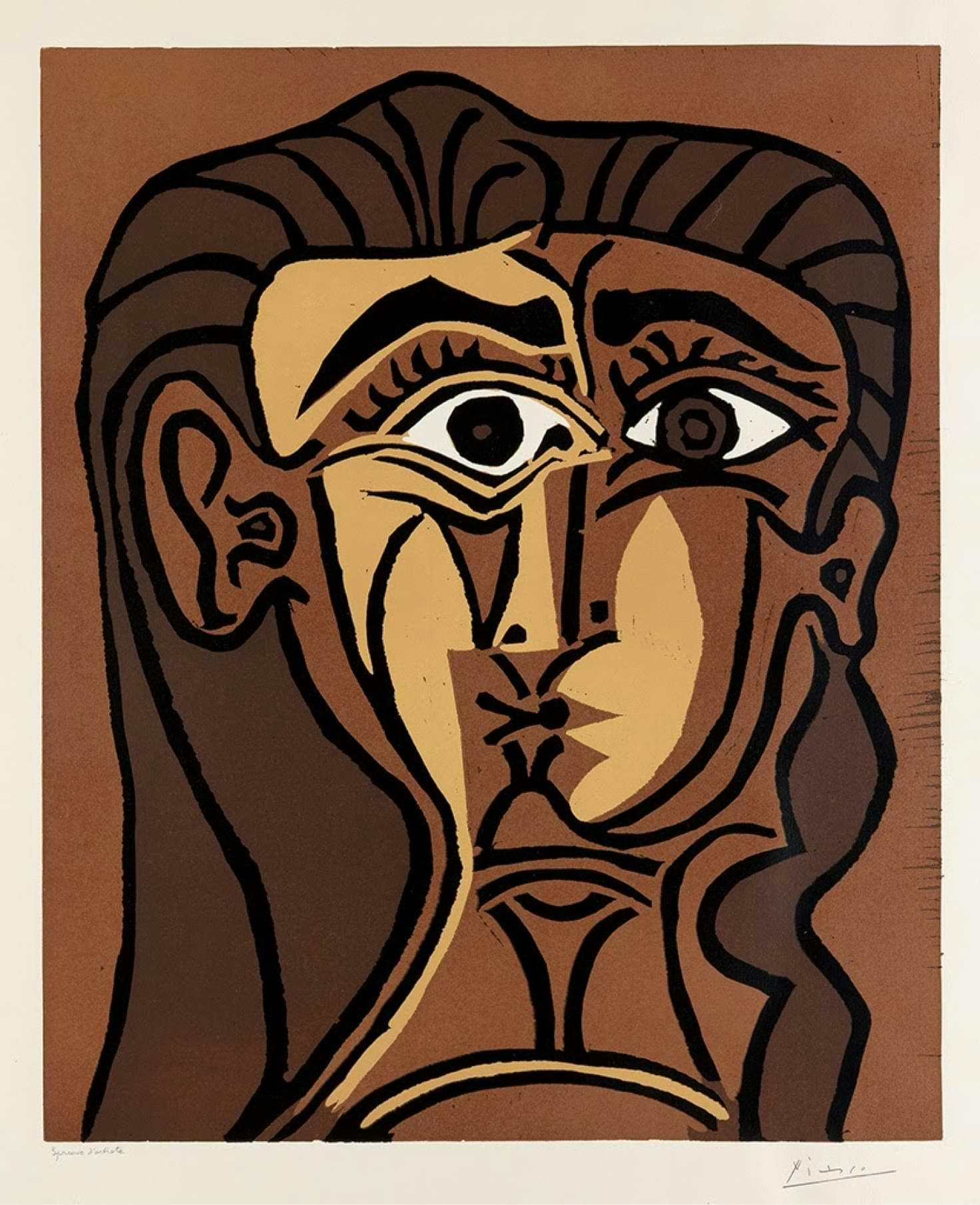
At its core, creating a linoleum or 'lino' print involves carving your design into a block made from lino material - hence where we get terms like "block print" or "relief print". Once carved, ink gets applied over the surface using tools like brayers (rollers). Then comes the magic part – pressing paper onto your inked block transfers your image.
This fascinating process takes us back to our early school days when we used potato stamps but on steroids. From simplistic designs all up to intricate masterpieces worthy enough for display at galleries worldwide; there are no limits except those set by one's imagination while working with linoleum blocks.
Linocut versus Other Relief Prints
You may be wondering how does this differ from other forms of relief printing? Good question. While techniques can overlap between various methods such as woodcut prints or even rubber stamping – they each have their quirks and characteristics which make them distinctively beautiful in their own rights.
Woodcuts, for example, give you a more rugged and organic feel due to the wood grain's texture. But lino cuts? They provide smooth surfaces ideal for bold designs with clear lines.
Historical artists, like Picasso, recognized this versatility in linocut prints and utilized it effectively within their work. This usage isn't limited to historical figures; even contemporary artists find allure in its potential today.
Wrapping things up (no need to fret - we're not calling it quits just yet)
Linocut is a distinctive and accessible form of art, similar to woodcutting and engraving. It offers unmatched versatility with its simplicity in creating designs on lino blocks which are then inked and transferred onto paper. With smooth surfaces ideal for bold lines, it's no wonder that greats like Picasso found this medium appealing.
Tools and Materials for Creating Linocuts
Diving into the world of linocut artistry, you'll quickly find that having the right tools can make all the difference. In this sea of possibilities, some stars shine brighter than others.
Selecting the Right Ink for Your Project
Let's talk about inks. It's like choosing between a juicy burger or a tender steak - both delicious but serving different purposes. The ink you choose needs to complement your project perfectly.
For a versatile and easy to clean option, consider using water-based inks. But if it's longevity and richness of color that gets your creative juices flowing, consider using safe wash relief ink such as Caligo Safe Wash Relief Inks - they're kind of like wine: sophisticated and timeless.
Importance of Quality Carving Tools
Moving on to carving tools. Think about them as utensils at a dinner party; without them things could get messy fast. When creating fine details on your lino block (the fancy canvas), sharpness matters more than a bear needing honey.
The most popular carving tool among artists is undoubtedly Power Grip Carving Tools due to their comfort grip handle which makes cutting through linoleum feel smoother than silk.
- Blick Battleship Gray Linoleum has won hearts with its quality texture just perfect enough not to damage those precious tools while making cuts so precise they would make Michelangelo jealous.
- In addition to the cutting tools, a rubber brayer is another must-have. It's like your trustworthy sidekick helping you evenly spread ink on your block.
- Speedball Soft Rubber Brayers are well-known for their durability and easy-to-clean nature - sort of like an everlasting gobstopper.
Wrapping it up, mastering linocut printmaking boils down to using the right tools at just the right moment. It's all about crafting art that truly resonates.
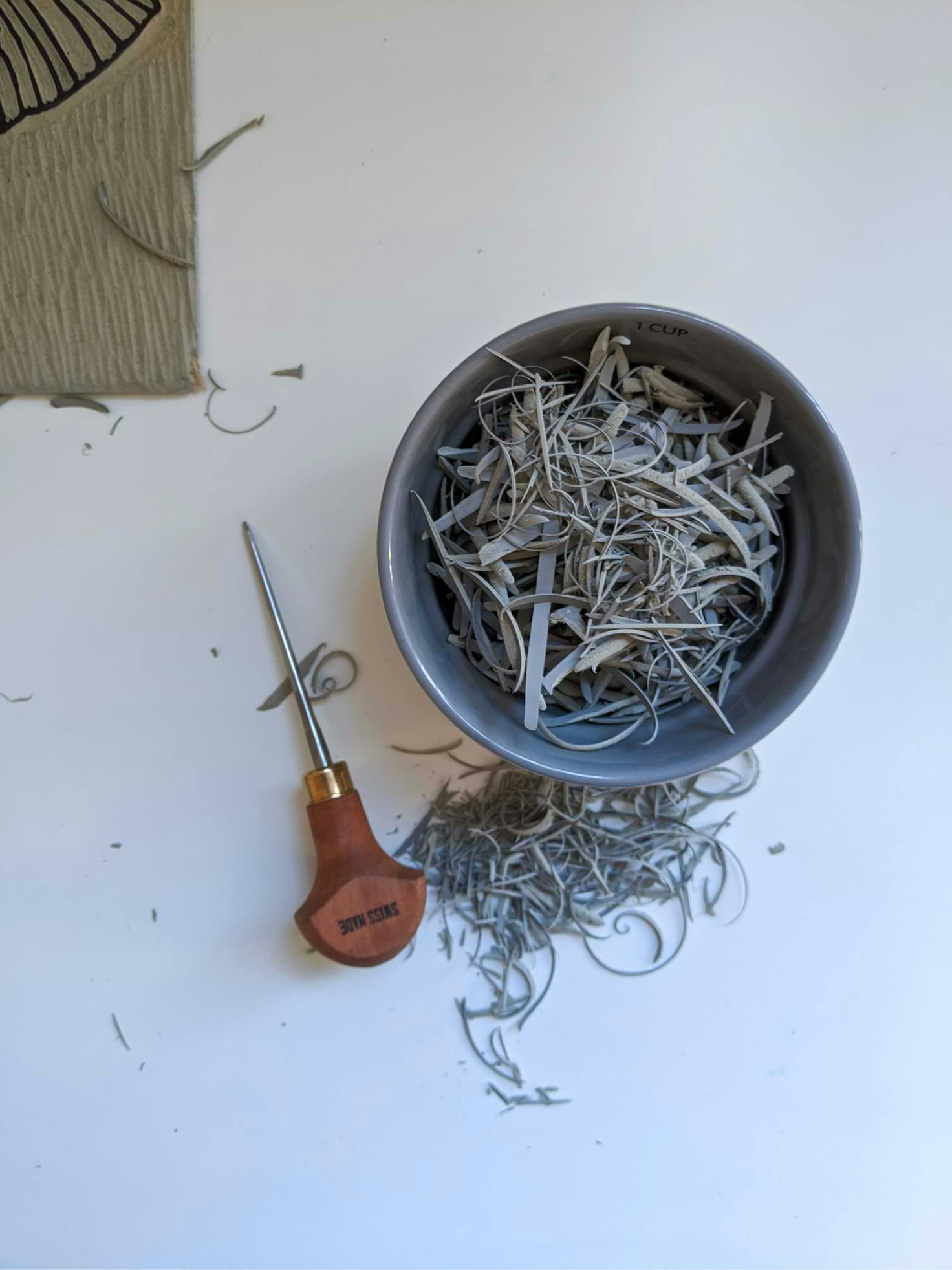
Diving into the world of linocut artistry, picking the right gear is crucial. Be smart about your ink selection - go for water-based if you value versatility and simple clean-up, or opt for safe wash relief for lasting impressions and vibrant color. Sharp carving tools are a must-have; many artists swear by Power Grip Carving Tools because they're easy on the hands. Remember to invest in quality.
The Process of Designing a Linocut
Constructing a linocut necessitates exactness, forbearance, and an astute eye for minutiae. It's like creating your own personal jigsaw puzzle where each piece must fit perfectly to create the final image.
The first step in designing a linocut involves sketching out your idea on paper. This initial sketch acts as the roadmap for your design, outlining fine details and identifying areas of negative space - much like planning the chapters of an exciting novel before diving into writing it.
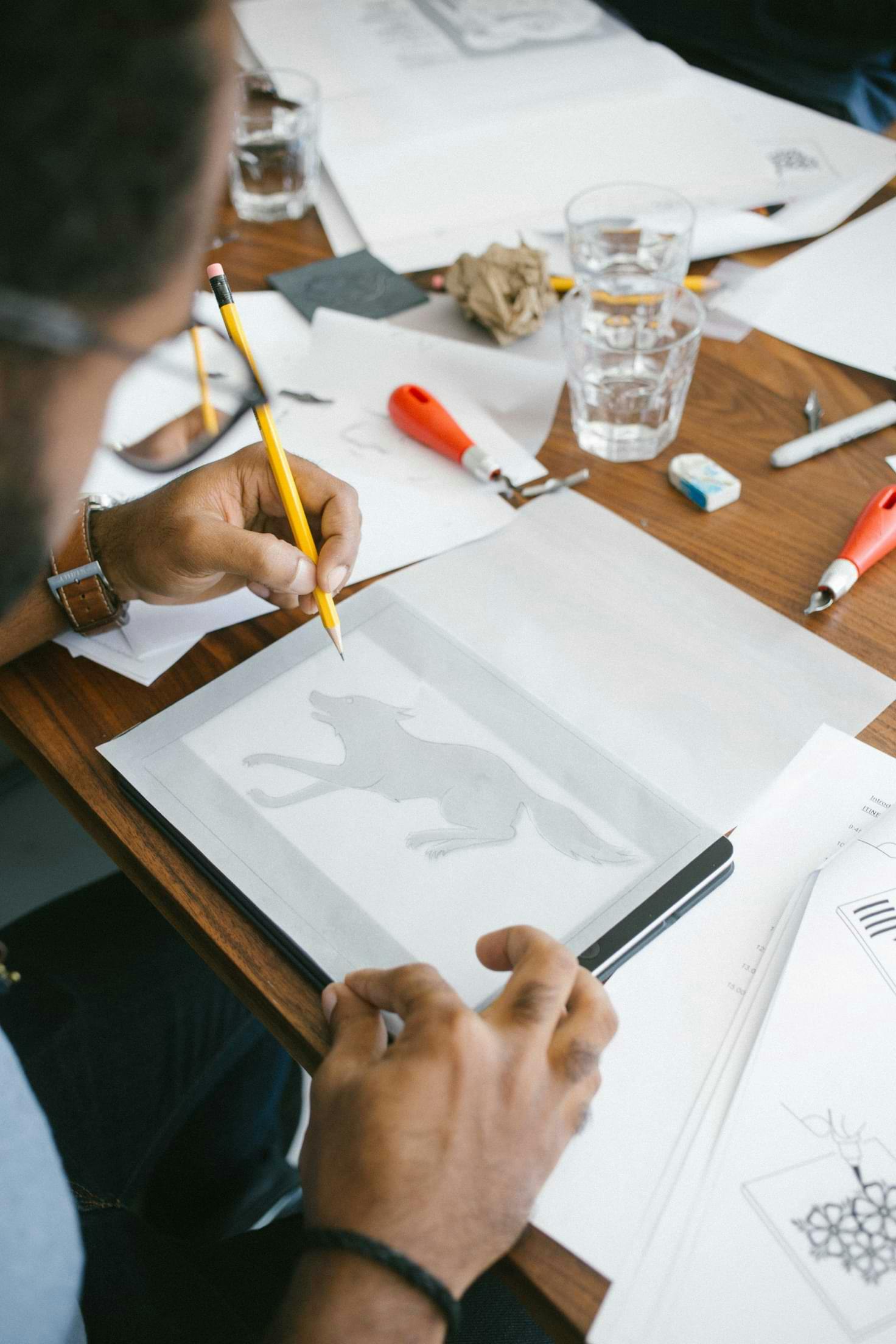
Selecting Your Materials
In addition to quality drawing materials, you'll need linoleum blocks (lino block) which serve as the canvas upon which our designs come alive. Much akin picking just-right type of wood for carving statues.
Moving from Paper Sketches onto Lino Blocks
Once satisfied with your sketches, it's time we transfer them onto lino blocks using carbon paper or freehand depending on preference; similar process used by artists during Renaissance period when preparing frescoes. Here Pencil Drawing Tips, may prove handy especially while capturing finer nuances manually.
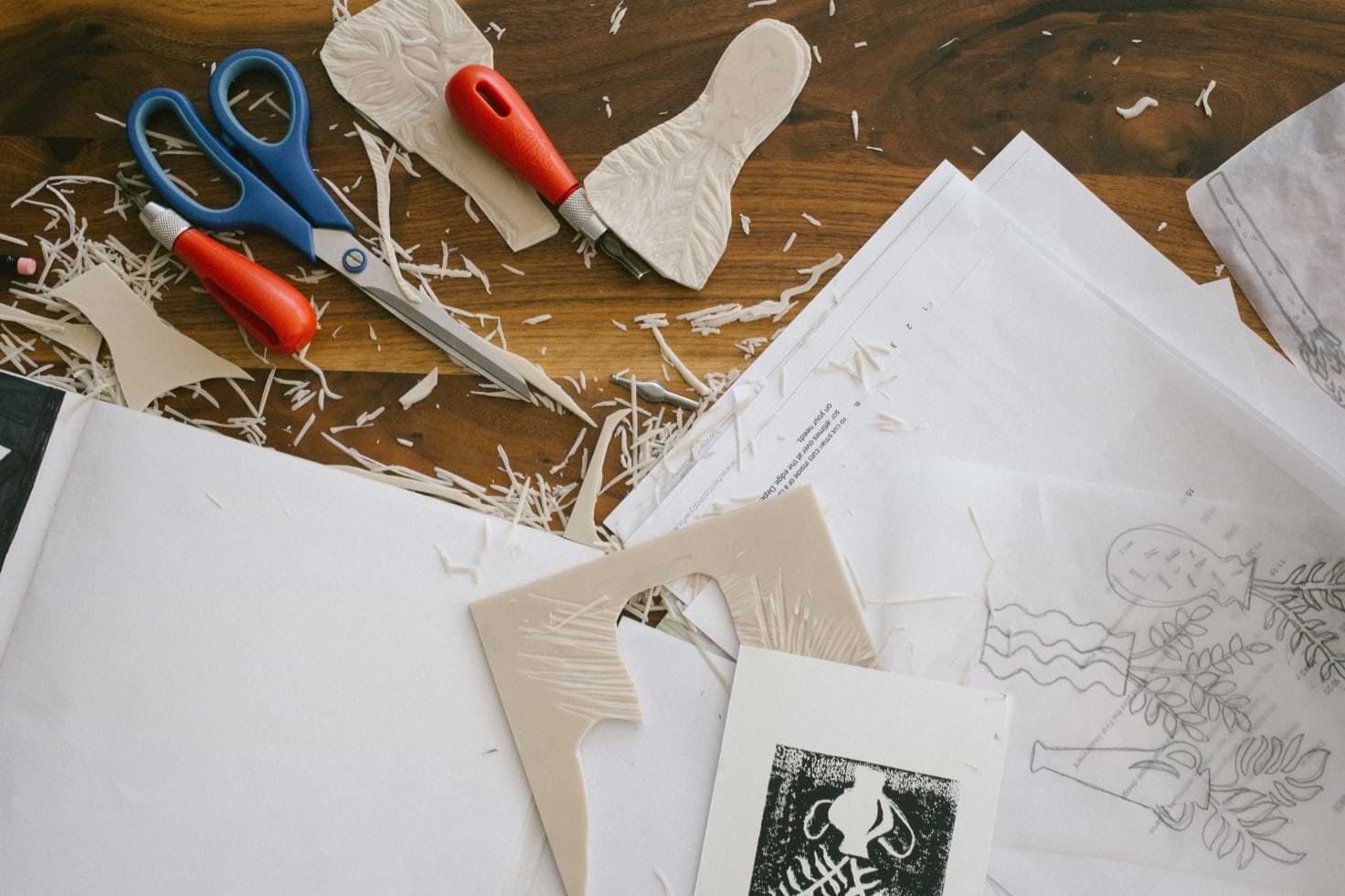
Fine-Tuning Your Designs
Your design isn't set in stone at this point though - think about these early stages as rough drafts in literature: necessary steps towards reaching the end goal. As you move through the process, it's important to continually evaluate and adjust your design as needed - a little like an author revising their draft manuscript.
Ultimately, the key to creating compelling linocut prints lies in patience, precision, and persistence - three qualities that are also paramount when crafting any masterpiece.
Think of crafting a linocut as solving an intriguing jigsaw puzzle, where every detail matters. It all kicks off with sketching your concept on paper - it's like mapping out the chapters of a thrilling novel. High-quality drawing tools and the perfect lino block are essential to breathe life into your design. The act of shifting sketches onto lino blocks is akin to translating a script into a stage play, where each line, curve, and texture is vital for conveying the narrative's essence.
Carving and Printing Your Linocut
The process of carving your linocut begins with choosing the right linoleum block. Battleship gray is a popular choice among artists due to its smooth texture. The magnitude of the block you select can fluctuate, yet recall that greater isn't constantly superior. Small blocks can yield intricate designs just as effectively.
Once you've got your lino block, it's time for some action. But hold on - we're not diving in headfirst without proper tools. Sharp cutting tools are essential for creating fine details in your design.
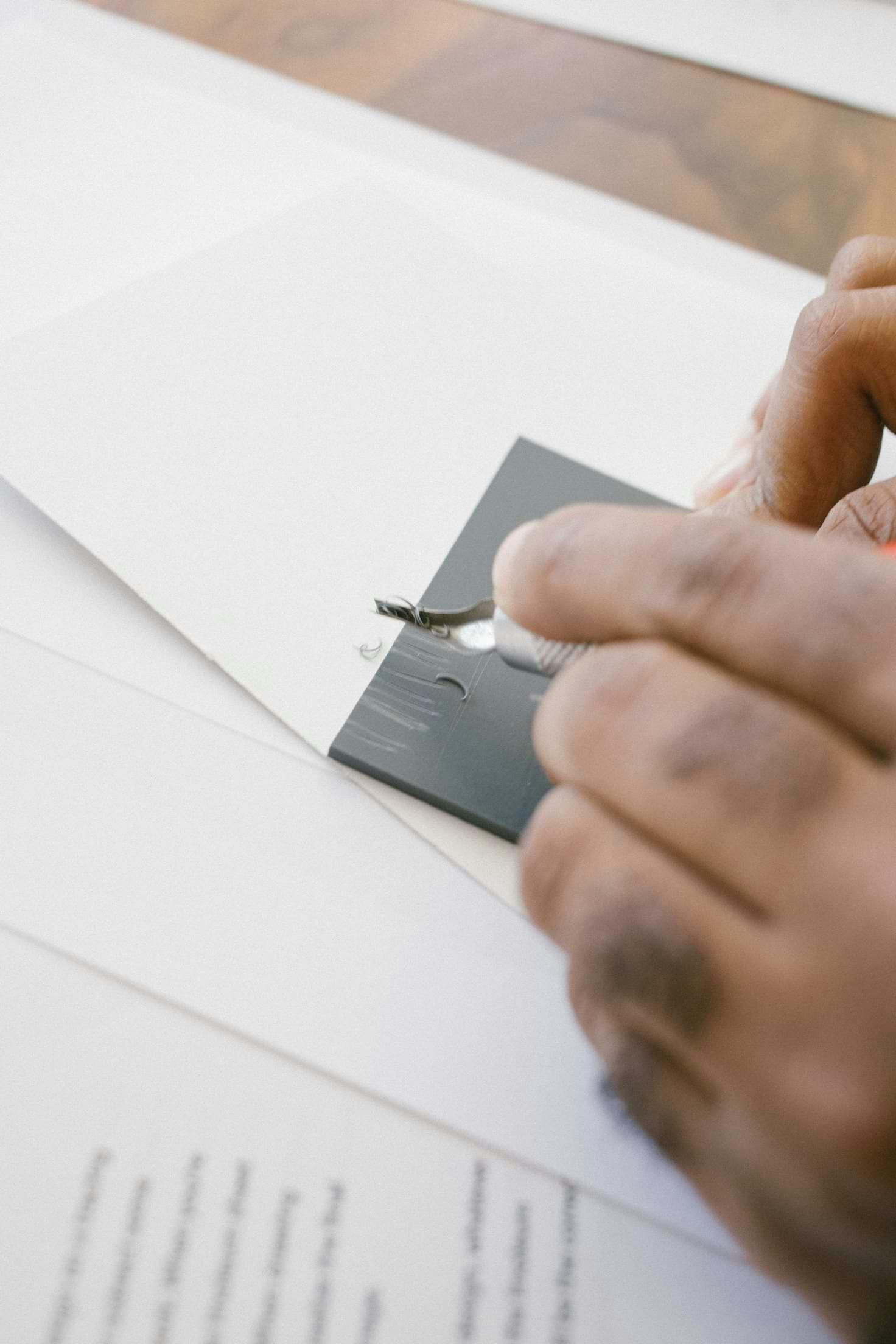
Choosing Cutting Tools
You need to pick sharp tools for this job; dull ones won't do any justice to your masterpiece. And when I say sharp, I mean sharper than Sherlock Holmes' deduction skills.
Gouges come highly recommended by many seasoned artists because they allow precise control over cuts and help achieve depth variations more easily than other types of cutting implements.
Inking the Block
A well-inked block gives birth to an excellent print. You want a nice even layer across all areas of the design – no dry patches or clumps allowed here folks.
Your printing ink matters too: whether it's black ink or vibrant colors, each one will give different effects on paper so don't be afraid to experiment (just maybe not with Picasso's "Guernica").
Relief Printing Process
This is where things get interesting - relief printing. A baren or wooden spoon may seem like odd choices but believe me; these humble kitchen items make perfect rubbing tools if you don't have an etching press at your disposal.
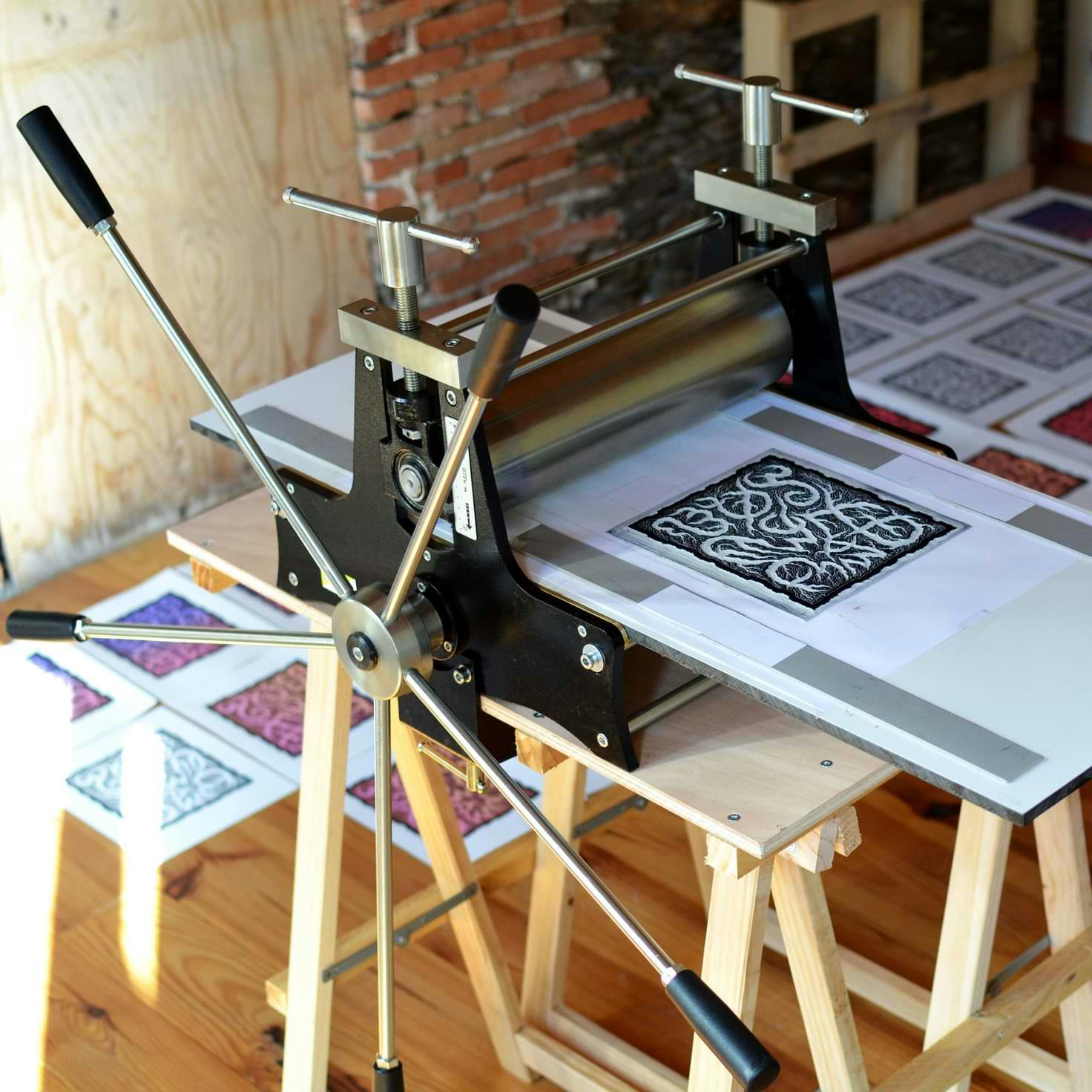
The goal is to apply even pressure across the entire block. And yes, it's just as therapeutic as popping bubble wrap - only way more artistic.
Celebrating Your Masterpiece
And voila. You've created a linocut print worthy of praise and admiration. This process may seem daunting at first, but with practice and patience, you'll be cranking out stunning lino prints like hotcakes off a griddle.

Start your linocut masterpiece by picking the perfect block, maybe battleship gray for its silky feel. Your go-to tools should be sharp cutters and gouges to craft detailed patterns. For inking, make sure you've got a uniform layer across all design elements - choose a printing ink that really pops on paper. When it comes to relief printing, grab a baren or even just a wooden spoon to apply pressure.
Techniques and Tips for Mastering Linocut
If you're looking to level up your linocut skills, there are a few essential techniques worth mastering. The art of making a linocut isn't just about cutting out designs on lino blocks; it's also about understanding the nuances of color application.
Exploring Color in Linocuts
Add some vibrancy to your prints by experimenting with colors. There are four ways to add color to your linocuts: hand coloring, color reduction, multi-block printing, and chin-colle'. Hand coloring lets you paint directly onto the print post-printing using watercolors or gouache.
The second technique is 'color reduction,' where multiple layers of different colored ink are applied sequentially on one block. But remember - each layer removes more material from the block.
'Multi-block printing' involves carving separate blocks for each color that needs applying while 'chin-colle'' gives an option to add colored paper during the process of printmaking itself.
TIP: Keep this handy trick in mind when exploring these techniques – always start with lighter colors first as darker ones can easily overpower them.
Cutting Techniques
In linocutting precision matters. Don't underestimate simple straight cuts; they provide crisp edges perfect for geometric patterns. For curvy shapes though, consider trying v-cuts or u-gouges.
Experimentation is key here. So feel free even if it means ruining a few lino blocks along the way – practice makes perfect after all.
Inking Your Block
Choosing the right ink can significantly impact your print. Block printing inks offer excellent coverage and dry slower, allowing for more extended working time. Remember to apply a thin layer of ink evenly across your block using a rubber brayer.
TIP: When it comes to printing, you don't need an expensive etching press. A wooden spoon or even your own hand can work wonders when used with care.
Mistakes Are Just Opportunities.
One thing's for sure when it comes to lin
Mastering linocut involves more than just cutting designs. It's about understanding color application, perfecting your cutting techniques, and choosing the right ink. Experiment with different coloring methods like hand coloring or multi-block printing to add vibrancy to your prints. Remember: in this art form, even mistakes are opportunities for learning.
Collecting and Appreciating Linocut Art
The world of linocut prints is a treasure trove for art collectors. It offers an affordable entry point into the fascinating realm of original artwork, without compromising on quality or creativity.
Limited edition linocut prints are especially intriguing to those with a keen eye for detail and appreciation for skillful handiwork. What's the significance of 'limited edition'? In essence, it refers to the total number of prints created from one design. The artist decides how many copies will be made - thus creating scarcity and increasing each print's value.
If you're new to collecting art online, start by exploring various artists' work. Look at their techniques, themes, color usage, and most importantly – how they resonate with your personal taste.
How Limited Edition Works in Linocuts
A key factor that makes limited-edition linocuts appealing is their exclusivity factor. Once an artist has decided on the size of an edition (let's say 50), no more than that number can ever be produced again using the same block.
This means if you manage to get hold of number 12 out of 50 - there'll only ever be 49 other exact versions around. That's pretty special when you think about it. Not just owning art but being part of its unique story as well.
Picking Your Prints: What To Consider?
Firstly, buy what speaks to your heart – after all; these pieces will adorn your space, possibly for years. So make sure they bring joy or spark thought each time you see them.
Secondly, consider the print quality and paper used – finer details that can greatly affect a linocut's lifespan.
Finally, remember to ask about the edition number. Lower numbers often hold more value - but sometimes later prints have their unique charm too.
Preserving Your Linocuts
Proper care of your precious linocuts ensures they last longer and retain their vibrancy over time.
Let's get started.
Dive into the rich world of linocut art, a collector's dream with affordable and creative pieces. Limited editions offer exclusivity - an exciting prospect for collectors. When choosing prints, go with what resonates personally and don't forget to check print quality and edition number. Proper care keeps your linocuts vibrant longer.
Preserving and Caring for Linocut Prints
The beauty of a linocut print lies in its timeless appeal. To ensure your prints remain vibrant, it is essential to understand how to take proper care of them.
Care Begins at the Printing Stage
Ink choice plays an essential role in preserving your artwork's longevity. For instance, Caligo Safe Wash Relief Inks are known for their resilience and color fastness. Likewise, selecting heavier weight paper helps ensure durability over time.
A well-executed printing process also contributes significantly towards extending the life of a linocut. Making sure that no excess ink is left on the surface can prevent damage caused by ink clumps hardening over time.
Storing Your Linocuts Safely
Paying attention to where you store your linoleum block prints can help maintain their original charm too. Always aim for cool, dry places out of direct sunlight – as this could cause colors to fade faster than they normally would.
To protect against dust or accidental smudging, consider investing in archival storage boxes specifically designed for artworks such as archival boxes.
Maintaining Cleanliness without Damage
If dirt does get onto your art piece somehow (let's face it - accidents happen), remember not all cleaning agents will be suitable due to potential chemical reactions with the ink or paper used.
Feel free to use a soft cloth lightly dampened with water if needed, but avoid abrasive materials which might scratch or mar surfaces inadvertently.
Appreciating Your Art Safely
If you choose to display your linocut prints, consider using UV-filtering glass frames. This will protect your artwork from harmful ultraviolet rays which could fade the colors over time.
The art of linocut printmaking is one that requires patience and precision during creation but also a bit of knowledge on how to preserve it post-production. So make sure you follow these steps for maintaining the longevity and beauty of your linocut prints.
For vibrant, long-lasting linocut prints, make smart choices throughout the process. Choose resilient inks and sturdy paper for printing, making sure to avoid excess ink clumps. Safely store your prints away from sunlight and dust using archival boxes. Clean them gently only when necessary to prevent damage. And remember, if you're displaying your artwork, UV-filtering frames are a great choice.
FAQs in Relation to What is Linocut
What does linocut mean in art?
In art, linocut refers to a printmaking technique where designs are carved into the surface of a block of linoleum and then inked for printing.
What is linocut printmaking?
Linocut printmaking is the process of carving an image onto a piece of lino, rolling it with ink, and pressing it onto paper or fabric to create prints.
What is special about linocut?
The uniqueness of linocuts lies in their bold contrast between printed areas and cut-away sections. It allows artists freedom for expressive mark-making that's both accessible and affordable.
What type of art is linocut?
A part of the relief printing family, Linocuts are versatile forms known for creating high-contrast images with striking lines and robust textures across various mediums like paper or fabric.
Conclusion
So, you've embarked on a journey into the world of linocut and uncovered its rich history. This unique art form is not just about carving lines onto a lino block - it's about storytelling through patterns and shapes.
You've discovered the essential tools needed for creating your masterpiece, from sharp carving instruments to quality printmaking paper. Each tool plays its part in bringing your vision to life.
What's more, you now understand how important sketching and transferring designs are in the process of making a linocut piece. These steps help ensure that your final print accurately reflects what was originally envisioned.
Achieving high-quality prints? You got this! The techniques we discussed should have equipped you with knowledge on how best to carve and ink your blocks for beautiful results.
Diving deeper into different color application methods opened up possibilities for creativity within this medium. Now it's time to apply those skills!
In summary: What is linocut? It's an accessible art form full of potential both as a creative outlet and affordable option for collectors everywhere! Let's keep exploring together!